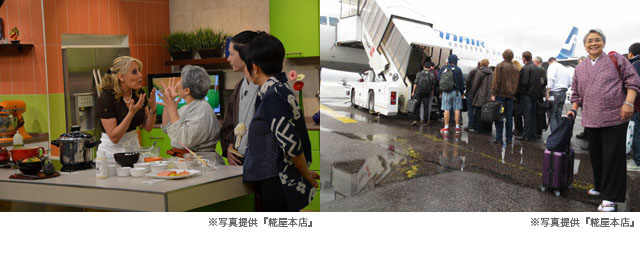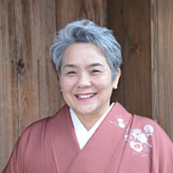Shio Koji, Salted Koji & Japanese Food with a Koji-ya
Jul 12,2013
Shio Koji, Salted Koji & Japanese Food with a Koji-ya
Jul 12,2013
Koji is a type of mold essential for making miso, soy sauce, saké, and other fermented foods. Recently, people have started to pay attention to koji again, but for a long time, it was a forgotten presence in most homes.
The person who lit the flame under the recent koji trend is Asari Myoho. She discovered salted koji (salt + koji + water) in old Edo-era documents and has been promoting its benefits as an all-purpose seasoning throughout Japan. This got us to wonder what her motivation is in working so hard to spread the koji message. And what is her view of the future of Japanese food culture?
We spoke with Asari while she was in Tokyo for an event.
▶Amazake: Discover the Delicate Charm of Japanese Sweet Sake
▶Sake Lees & Sake Kasu: Fermented Flavor in Daily Cooking

*Photos courtesy of Kojiya Honten
—Can you tell us how you came to travel all over the country, starting in 2007, as the Koji-ya [koji store] Proprietress?
“I felt the culture of making fermented seasonings at home using koji was at risk of dying out if nothing were done about it. In the past, every household used koji to make its own miso and soy sauce, and each household had its own taste — the taste of mom’s cooking.
“So I wanted to revive the culture of homemade food to people’s kitchens. In families today, both parents and kids are busy with their own activities and have less opportunities to sit down together around the dinner table. I feel the moments where the whole family is gathered together, enjoying a good conversation and laughing as they eat something delicious, are truly happy times. No matter how busy you are, you can cook up something quick and prepare a delicious meal in no time. I want people to use koji to invigorate their body and soul and bring back the smiles that brighten family dinners. I started taking action with that singular wish.”
—From there, you were inspired by the tsukedoko pickling beds for salted koji in Honcho Shoku Kagami [Model Recipes for Our Nation’s Cuisine] — a publication from the Edo period (1603 to 1868) — to come up with salted koji.
“I didn’t develop it. All I did was slightly modify the way koji had been used long ago. I picked up on the truth that lies dormant in the old ways of doing things, and the gods of koji taught me to add and enjoy new ideas.”
—The power of fermentation brings the umami flavors of food ingredients to the fore, while also reducing salt intake. [Salted koji achieves the same degree of saltiness with about a quarter of the amount of salt.] Salted koji can be seen as a true all-purpose seasoning for the 21st century.
“Just adding salted koji makes you feel like a master chef, right? It also helps to preserve ingredients if you coat them with salted koji, so it’s a useful seasoning and a lifesaver for busy moms and working women. Even when you come home tired from work, just a little extra effort and some love is all it takes to hear your kids say: ‘This is delicious!’ Those exclamations make your tiredness disappear. And reducing salt intake is a big problem globally, not just in Japan. Compared to miso or soy sauce, which take six months to a year to make, salted koji can be ready in a week to 10 days. The reason why so many people have taken to using salted koji is its convenience, which suits the daily routines of people today. People can’t wait six months, but they can wait a week.”
—You specifically did not trademark salted koji. Moreover, you have generously published the method for making salted koji and related recipes in books and on the Kojiya Honten website. What was your intention behind these moves?
“It was an option to have trademarked salted koji and protected it. But my desire was to make more people aware of the power of koji and to make use of koji. I wanted salted koji to be the killer product that would resurrect and breathe new life into koji stores around the country. And, honestly, I did not invent salted koji; I merely arranged the very old method of salted koji pickling for the modern age and taught people how to use it. My recipes are based on camp cooking, so most of them are simple. If you go camping near the sea or in the mountains, you only need to take one packet of salted koji. I hope people will further develop and apply my salted koji recipes and discover ways to use salted koji that best suit them. I want people to enjoy the creativity of cooking, asking themselves: ‘What would this taste like with salted koji?’ or ‘How will it turn out if I use it like this?’ When a recipe clicks, you’ll get a great sense of confidence and build your self-esteem.”


*Photos courtesy of Kojiya Honten *Photos courtesy of Kojiya Honten
—You have expanded your scope beyond Japan to the world, travelling to Italy, the United States, Paraguay, Germany, and Belgium last year and to France and Mexico this year.
“Salt is a seasoning used in cooking everywhere in the world. Simply substituting salted koji for salt leads to lower salt intake, and it pairs well with any ingredient and enhances flavors. When I made salted koji sausages in Germany, they were a huge hit with everyone. People said to me: ‘How come they are so delicious? This seasoning is like magic.’ To live is to eat. Being able to eat local, seasonal produce deliciously is a delight for everyone. My wish is to make everyone everywhere happy by making their bellies feel good. What people need is not weapons, but koji. Gathering around a table and eating on good terms naturally causes people to smile and become friendly. If you can smile at each other and understand each other, arguing will seem silly to you. I firmly believe if we can invigorate the dining tables of the world with the power of koji and recognize and respect each other, then war will become a thing of the past. I’m aiming to use koji to win the Nobel Peace Prize. (laughs)”
—The potential of koji is that great, isn’t it.
“It’s very difficult to convey the wonder of koji, and it’s basically impossible to communicate its benefits and attractions in words. But once they have a taste, people are convinced. I love the instant when someone who has never tasted food made with koji tries some and I can see the look of amazement on their face. I tell them: ‘See. I told you it’s delicious.’ I travel all over to share this feeling and to bring this joy to others. I highly enjoy my work, rather than working myself to death on assigned tasks. I love meeting new people, and my lifelong goal is to connect with and become friends with as many people as possible both in Japan and abroad. Thanks to koji, the number of friends I’ve made is soaring. (laughs) There are no limits on the possibilities of koji. Think of miso, for example, that is made with soybeans, koji, and salt. There was a saying in the Edo period that if the miso shops are doing well, the doctors will turn pale from losing business. This tracks, since soybeans are packed with important nutrients that are good for the body and fermentation accentuates the nutrients even further. I will keep on telling everyone about the wonder of koji and fermented seasonings, and I will continue to help people lead happy lives, starting with healthy bellies, through Japanese food and the food of countries everywhere.”
▶Amazake: Discover the Delicate Charm of Japanese Sweet Sake

Asari Myoho was born in 1952 in Saiki, Oita, as the eldest daughter to the owner of Kojiya Honten, a specialty koji store founded in 1689.
After graduating from a Tokyo college and working in management at a private-tutoring school, she began calling herself the Koji-ya Proprietress in 2007 and has since devoted herself to promoting and disseminating koji culture. Mother of three sons and two daughters, she has written several books including Koji Recipes: Discovering New Truths By Looking at the Past and Kojiya Honten’s Salted Koji Recipes.